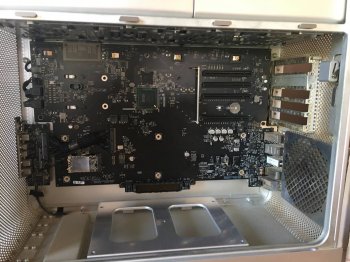I've read through many threads @MacRumors and I haven't found a solution for my specific problem yet.
My system setup:
Mac Pro 5,1 Mid-2010 Westmere
Dual Quad Core 2.4
Samsung SSD 500GB (as startup/boot disk)
16 GB RAM
3x WD 4TB Disks
Sapphire HD 7970 3GB -> It's brand new and for Mac Pro 4,1 / 5,1
Mac OS X 10.13.5
My Mac was running perfectly fine for years now and ran on the latest Mac OS 10.13.5 for some time now.
A few days ago, I shut down my Mac and tried booting it a day later. Since then both of my screens are staying black. At that time I had an older graphic card installed (the Sapphire HD 7970 is new and was installed yesterday, because my first assumption was that it might be some issue with the GPU).
When I switch on the Mac the following things happen:
So now my question:
Does anyone have an idea what it could be or how I should proceed to figure out the problem?
Are there any LEDs that should lighten up but aren't at the moment?
I really appreciate any answer or hint that helps me solve that problem
My system setup:
Mac Pro 5,1 Mid-2010 Westmere
Dual Quad Core 2.4
Samsung SSD 500GB (as startup/boot disk)
16 GB RAM
3x WD 4TB Disks
Sapphire HD 7970 3GB -> It's brand new and for Mac Pro 4,1 / 5,1
Mac OS X 10.13.5
My Mac was running perfectly fine for years now and ran on the latest Mac OS 10.13.5 for some time now.
A few days ago, I shut down my Mac and tried booting it a day later. Since then both of my screens are staying black. At that time I had an older graphic card installed (the Sapphire HD 7970 is new and was installed yesterday, because my first assumption was that it might be some issue with the GPU).
When I switch on the Mac the following things happen:
- I see two red lights flashing once for a millisecond on the left and right side of each processor
- The SSD seems to go through the regular startup process
- I hear the chime
- The LED on the front panel is looking fine with a constant light blue light
- I checked the System LEDs and I have the following:
- CPU A (off)
- CPU B (off)
- PWROK (green)
- 5V STBY (amber)
- 3.3 V (off)
- 1.5 V (off)
- 1.05 V (off)
- CPU A (off)
- The other LEDs further below show:
- SYS.PG (green)
- PLT.RS (off)
- RI.PG (off)
- EFI DONE (off)
- GPU OK (green)
- 5V (off)
- RSN RST (off)
- I hope I got everything right here - but to make sure that it's correct I am attaching the picture as well

- No matter how long I wait, the monitors are receiving a signal but are staying black
- I switched / removed RAM (startet with 2 in slot 1 & 2, started with 4 in slot 1 - 4, started with 4 in slot 1 & 2 as well as 5 & 6
- I removed all external devices (USB / Network / Audio)
- I also removed all HDDs except the SSD (which is working fine connected to a MacBook Pro with an external inateck HDD reader)
- I reinstalled OS X 10.13.5 (I am currently trying to reinstall OS X 10.13.0 from a backup)
- I checked both monitors, cables, etc. - they are both working perfectly fine
- I checked both processors, they are cooled properly, there should be no problem with overheating
- I figured out that neither the front nor the backpanel USB / Network is constantly powered.
Sometimes when I boot the Mac, the USB Keybord is getting power, more often it is not - independent of where I connect it. It currently is the only USB device that is connected to the Mac anyways. - I also reset the PRAM and SMC and also changed the battery.
- I also switched (the old and the new) graphic card slots.
So now my question:
Does anyone have an idea what it could be or how I should proceed to figure out the problem?
Are there any LEDs that should lighten up but aren't at the moment?
I really appreciate any answer or hint that helps me solve that problem







